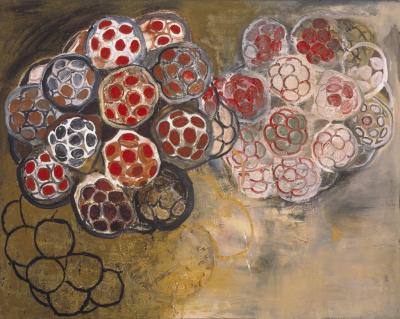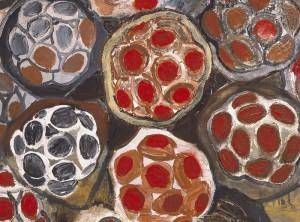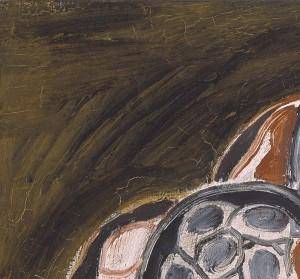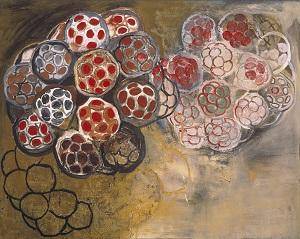
Rhyme
Terry Winters, United States
1992
68 in. x 86 in.
Funds from the Bonfils-Stanton Foundation, 1986.74
Photograph © Denver Art Museum 2009. All Rights Reserved.
Terry Winters was born in Brooklyn, New York, in 1949. He has a keen interest in science and scientific breakthroughs and is knowledgeable about computer simulations, genetic mapping, and electronic microscopes. Winters’ enthusiasm for science manifests itself in his art, as he often finds inspiration for his paintings in the biological forms found in nature. He has researched the sources of ancient pigments used to create color in paints and dyes, and he has even ground pigments to make his own paints. In effect, he has stretched the creative act to include making the very materials with which his art is created. Winters spent ten years focused almost solely on developing his approach to painting, postponing any exhibiting of his artwork until he had worked out his own relationship to the creative task.
“I’m interested in how to give a picture of these things we can’t see,” says Winters. Rhyme has endless possibilities for interpretations, as Winters’ paintings draw from a variety of sources at once. His early sketches of plant parts—like pods, spores, and stamens—that he found in natural history museums and books became the starting point for the subject matter of his paintings. Images of hot air balloons, soccer balls, sponges, and soap bubbles fill his sketch books and lend qualities to the forms he creates. Yet despite the real-world origin of his imagery, Winters doesn’t aim to represent specific processes or structures through his paintings. Ideas that are rooted in biology and chemistry take on a life of their own when they reach the canvas.
Winters is also interested in the forces of the natural world that fall outside human perception. At any given moment there are several—perhaps innumerable—forces at work that extend beyond the realm of what we can perceive. We cannot hear sounds that fall outside a certain range, see light at certain wavelengths, or distinguish molecular interactions with the naked eye, yet we experience the effects of these interactions and conditions. These indefinable, imperceptible, but nonetheless existing occurrences are the kinds of things Winters tries to depict in his paintings.
Details

Circles
You can see two distinct groupings of circular shapes in this painting. Each circular shape is made of smaller cell-like clusters which enclose even more circular forms. What might these groupings of circles mimic? Soap bubbles? Insect eyes?

Incomplete Forms
The black circular forms in the lower left portion of the painting appear to be incomplete and seem to mimic the two more defined circular groupings. There is also another vague cluster of circles outlined in yellow paint. Just as the forms in Rhyme might evoke the building blocks of life, these incomplete shapes might suggest the building blocks of Winters’ creative process.

Traces of the Paintbrush
You can see evidence of Winters’ gestures, particularly in the upper left-hand corner of the painting. Notice how the dark brown background lightens and blurs into the lower left portion of the surface.

Title
For Winters, titles are an essential part of the creation and experience of his paintings. Like his forms, his titles do not link his paintings to the real world in any linear or logical way. As he works on a given painting, verbal associations arise in his mind, and in turn, influence the evolution of the painting.
More Resources
Interview with Terry Winters at the Tate Gallery
Websites
Terry Winters Biography and Artworks
A short biography of Winters with images of his work, from Leslie Sacks Fine Art.
Books
Tuma, Kathryn, and Terry Winters. Terry Winters: Knotted Graphs. New York: Matthew Marks Gallery, 2009.
This book presents a series of Winters’s paintings and drawings made in 2007 and 2008 that further investigate the grid through mathematical principles such as knot theory
Ackley, Clifford, Sharon Corwin, and Terry Winters. Terry Winters: Prints & Sequences. Waterville, Maine: Colby College Museum of Art, 2006.
The Colby College of Art is the sole repository for Winters' entire archive of prints, and this book presents a selection from the collection.
Children's Books
Banyai, Istvan. Zoom. New York: Puffin, 1998.
This book is used in the elementary lesson plan; it recreates page by page the effects of a camera zooming out.
Funding for object education resources provided by a grant from the Morgridge Family Foundation. Additional funding provided by the William Randolph Hearst Endowment for Education Programs, and Xcel Energy Foundation. We thank our colleagues at the University of Denver Morgridge College of Education.
The images on this page are intended for classroom use only and may not be reproduced for other reasons without the permission of the Denver Art Museum. This object may not currently be on display at the museum.
